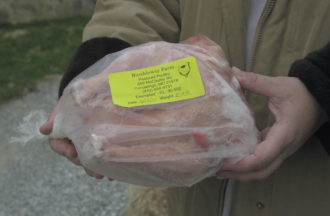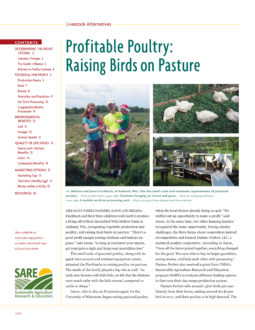
The experience of practically every range-poultry producer bears this out: Marketing your product will take as much time and energy as the actual task of raising and processing your product.
In a survey, 80 percent of APPPA members cited direct marketing as a top sales method. For most, the best way to reach family, neighbors and others in the community is word of mouth, posting flyers on local bulletin boards, selling products at farmers markets and contacting customers often.
Marketing Tips
Pre-Orders
Many producers pre-sell their pastured poultry, asking a small deposit that is credited to the customer when the birds are processed. Typically, a buyer that pre-orders is an excellent customer to have, and efforts should be made to show appreciation for these customers. The deposits help with cash flow, paying for some of the up-front feed and processing costs.
Among all poultry, customers are most willing to pre-order Thanksgiving and Christmas turkeys, and are often willing to pay higher prices on these special occasions.
Samples
Robin Way not only praises the virtues of investing in a colorful, easy-to-spot farm sign, she recommends giving out free meat, including donations at local events. “If they take the trouble to drive down our lane, I’ll give people freebies,” she said.
Farmers selling directly to local stores or restaurants find that giving samples helps. They have to be passionate, tell the person in charge what to look for in their product, why what they produce is different, why it is worth the premium. Then the meat manager, or the chef, will pass on that understanding and value to customers.
Selling with Other Products
Delehanty, the New Mexico grower, markets his organic meat under a “Real Chicken” brand that commands premium prices—in 2011, as high as $5 per pound at upscale grocery stores in nearby cities. Next, he plans to sell organic vegetables he expects will flourish in the manure-rich soil aided by his flocks. He thinks communicating the symbiotic relationship between his birds and produce will help sell both.
One grower who works with James McNitt at Southern University has a ready market for her pastured poultry partly because she already has dedicated customers for her organic blueberries. “And people are pushing her to do more,” he said.
Many community supported agriculture (CSA) operations are open to offering egg and meat options to customers. “It really diversifies the CSA share,” said Spencer of NCAT. “It helps the CSA become more of a one-stop shop. If there is a CSA nearby, and you’re a poultry producer, just go and see if there’s an egg or poultry need that you can fill. Often this is a win-win situation.”
The Extra-Healthy Egg?
Some producers are trying to capitalize on the ability to enrich eggs with omega-3 fatty acids, which lower cholesterol and thus have been linked to reduced risk of heart disease in humans. Any chicken on pasture will consume omega-3s in the forages they eat, and the more lush the pasture, the more nutrients consumed. Also, flax, commonly grown as an oilseed, can be added to hen rations at about 15 percent. Researchers at the University of Nebraska have found that so-called “omega eggs” can reduce saturated fat by one-third.
Niches within a Niche
Thirty-one percent of the respondents to an APPPA survey raise turkeys along with pastured broilers. Sixty-nine percent raise layers. Many also report raising varieties of poultry other than chickens and turkeys, including ducks, guinea fowl and pheasant hens.
Specialty fowl such as ducks can be raised with as little effort as is required for other poultry, but can bring in much more money per pound. Their rareness also tends to make the job of marketing easier. Restaurants can offer good markets for exotic fowl, and if state regulations allow direct sales to restaurants, it is worth contacting the chefs at every upscale establishment in the area.
